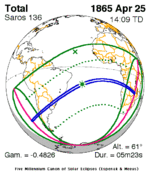Solar eclipse of June 8, 1937
| Solar eclipse of June 8, 1937 | |
|---|---|
 Map | |
| Type of eclipse | |
| Nature | Total |
| Gamma | -0.2253 |
| Magnitude | 1.0751 |
| Maximum eclipse | |
| Duration | 424 sec (7 m 4 s) |
| Coordinates | 9°54′N 130°30′W / 9.9°N 130.5°W |
| Max. width of band | 250 km (160 mi) |
| Times (UTC) | |
| Greatest eclipse | 20:41:02 |
| References | |
| Saros | 136 (33 of 71) |
| Catalog # (SE5000) | 9369 |
A total solar eclipse occurred on June 8, 1937. A solar eclipse occurs when the Moon passes between Earth and the Sun, thereby totally or partly obscuring the image of the Sun for a viewer on Earth. A total solar eclipse occurs when the Moon's apparent diameter is larger than the Sun's, blocking all direct sunlight, turning day into darkness. Totality occurs in a narrow path across Earth's surface, with the partial solar eclipse visible over a surrounding region thousands of kilometres wide. The path of totality crossed the Pacific Ocean starting in Gilbert and Ellice Islands (now belonging to Tuvalu and Kiribati) on June 9th (Wednesday ), and ending at sunset in Peru on June 8th (Tuesday). At sunrise totality lasted 3 minutes, 6.8 seconds and at sunset totality lasted 3 minutes, 5.1 seconds. American astronomy professor Ethelwynn Rice Beckwith traveled to Peru to see this eclipse, and described the event in detail for the Oberlin Alumnae Magazine in 1937, in an article titled "Three Minutes in Peru."[1]
With a maximum eclipse of 7 minutes and 4.06 seconds, this was the longest total solar eclipse since July 1, 1098 which lasted 7 minutes and 5.34 seconds. A longer total solar eclipse occurred on June 20, 1955.[2]

Related eclipses[]
Solar eclipses 1935–1938[]
This eclipse is a member of a semester series. An eclipse in a semester series of solar eclipses repeats approximately every 177 days and 4 hours (a semester) at alternating nodes of the Moon's orbit.[3]
| Solar eclipse series sets from 1935–1938 | ||||
|---|---|---|---|---|
| Ascending node | Descending node | |||
| 111 | January 5, 1935 Partial |
116 | June 30, 1935 Partial | |
| 121 | December 25, 1935 Annular |
126 | June 19, 1936 Total | |
| 131 | December 13, 1936 Annular |
136 | June 8, 1937 Total | |
| 141 | December 2, 1937 Annular |
146 | May 29, 1938 Total | |
| 151 | November 21, 1938 Partial | |||
Saros 136[]
Solar Saros 136, repeating every 18 years, 11 days, contains 71 events. The series started with partial solar eclipse on June 14, 1360, and reached a first annular eclipse on September 8, 1504. It was a hybrid event from November 22, 1612, through January 17, 1703, and total eclipses from January 27, 1721, through May 13, 2496. The series ends at member 71 as a partial eclipse on July 30, 2622, with the entire series lasting 1262 years. The longest eclipse occurred on June 20, 1955, with a maximum duration of totality at 7 minutes, 7.74 seconds. All eclipses in this series occurs at the Moon's descending node.[4]
| Series members 29–43 occur between 1865 and 2117 | ||
|---|---|---|
| 29 | 30 | 31 |
 Apr 25, 1865 |
 May 6, 1883 |
 May 18, 1901 |
| 32 | 33 | 34 |
 May 29, 1919 |
 Jun 8, 1937 |
 Jun 20, 1955 |
| 35 | 36 | 37 |
 Jun 30, 1973 |
 Jul 11, 1991 |
 Jul 22, 2009 |
| 38 | 39 | 40 |
 Aug 2, 2027 |
 Aug 12, 2045 |
 Aug 24, 2063 |
| 41 | 42 | 43 |
 Sep 3, 2081 |
 Sep 14, 2099 |
 Sep 26, 2117 |
Tritos series[]
This eclipse is a part of a tritos cycle, repeating at alternating nodes every 135 synodic months (≈ 3986.63 days, or 11 years minus 1 month). Their appearance and longitude are irregular due to a lack of synchronization with the anomalistic month (period of perigee), but groupings of 3 tritos cycles (≈ 33 years minus 3 months) come close (≈ 434.044 anomalistic months), so eclipses are similar in these groupings.
| Series members between 1901 and 2100 | |||
|---|---|---|---|
 September 9, 1904 (Saros 133) |
 August 10, 1915 (Saros 134) |
 July 9, 1926 (Saros 135) | |
 June 8, 1937 (Saros 136) |
 May 9, 1948 (Saros 137) |
 April 8, 1959 (Saros 138) | |
 March 7, 1970 (Saros 139) |
 February 4, 1981 (Saros 140) |
 January 4, 1992 (Saros 141) | |
 December 4, 2002 (Saros 142) |
 November 3, 2013 (Saros 143) |
 October 2, 2024 (Saros 144) | |
 September 2, 2035 (Saros 145) |
 August 2, 2046 (Saros 146) |
 July 1, 2057 (Saros 147) | |
 May 31, 2068 (Saros 148) |
 May 1, 2079 (Saros 149) |
 March 31, 2090 (Saros 150) | |
See also[]
- Kanton Island § Americans arrive - describing events where a Pacific island disputed between the UK and the US was used to view the eclipse
Notes[]
- ^ Beckwith, Ethelwynn Rice (November 1937). "Three Minutes in Peru". Oberlin Alumnae Magazine: 2–3 – via Internet Archive.
- ^ Espenak, Fred. "Total Solar Eclipses with Durations Exceeding 07m 00s: -3999 to 6000". NASA Eclipse Web Site.
- ^ van Gent, R.H. "Solar- and Lunar-Eclipse Predictions from Antiquity to the Present". A Catalogue of Eclipse Cycles. Utrecht University. Retrieved 6 October 2018.
- ^ SEsaros136 at NASA.gov
References[]
- Earth visibility chart and eclipse statistics Eclipse Predictions by Fred Espenak, NASA/GSFC
- Fotos of Solar Corona June 8, 1937
- Total solar eclipses
- 1937 in science
- 20th-century solar eclipses
- June 1937 events



